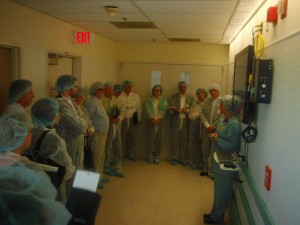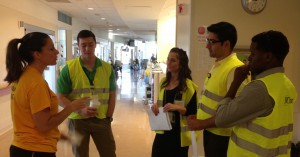In lean speak, you have to go to the “gemba”, that place where the work is done. 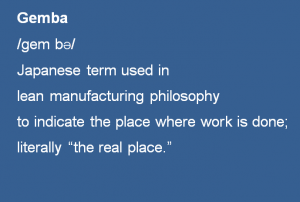 To go to the “gemba,” I rounded with some of my colleagues in the early days of our inpatient Epic go live. They included our Chief Medical Informatics Officer (CMIO), the executive director of our children and women’s hospital, and our Chief Nursing Officer (CNO). We visited many different inpatient units – to listen to staff tell us how it was going and describe issues. It reminded me that I need to once again make time to regularly round with our users. Continue reading
To go to the “gemba,” I rounded with some of my colleagues in the early days of our inpatient Epic go live. They included our Chief Medical Informatics Officer (CMIO), the executive director of our children and women’s hospital, and our Chief Nursing Officer (CNO). We visited many different inpatient units – to listen to staff tell us how it was going and describe issues. It reminded me that I need to once again make time to regularly round with our users. Continue reading
Author Archives: Sue Schade
MiChart – the beat goes on
Walking down the hall at our University Hospital last week, I ran into a UMHS senior leader I hadn’t seen in weeks. 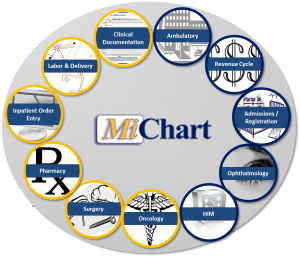 He asked me how MiChart was going – that’s the program name for our new integrated electronic health record. I said “very well.” I joked there are no picket lines outside my office and I’m not getting nastygram emails. I’m actually getting to focus on a lot of other things now, compared to those first few weeks after our MiChart Stage 3 inpatient go live two months ago. Our clinicians and other staff are adapting pretty well and, overall, things are going smoothly.
He asked me how MiChart was going – that’s the program name for our new integrated electronic health record. I said “very well.” I joked there are no picket lines outside my office and I’m not getting nastygram emails. I’m actually getting to focus on a lot of other things now, compared to those first few weeks after our MiChart Stage 3 inpatient go live two months ago. Our clinicians and other staff are adapting pretty well and, overall, things are going smoothly.
With this stage of our Epic implementation completed, we now have an integrated system across ambulatory, inpatient, hospital outpatient departments, and revenue cycle. Continue reading
On the lean journey
I recently heard Amir Dan Rubin, president and CEO of Stanford Hospital & Clinics, describe the three plus year lean journey of his organization. While those in the audience were impressed and even 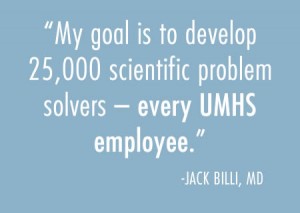 salivating over what they have accomplished, Amir was the first to say they have much more to do. A true journey it is. Even leaders from some of the organizations we want to emulate say they have many miles ahead on the lean journey.
salivating over what they have accomplished, Amir was the first to say they have much more to do. A true journey it is. Even leaders from some of the organizations we want to emulate say they have many miles ahead on the lean journey.
What is lean? According to the Lean Enterprise Institute, “the core idea is to maximize customer value while minimizing waste. Simply, lean means creating more value for customers with fewer resources.”
Amir Rubin and John Shook, the CEO of the Lean Enterprise Institute – both national thought leaders in lean thinking – were the keynote speakers during the Healthcare Value Network (HCVN) site visit that the University of Michigan Health System hosted last month.
The network is a learning collaborative of health care organizations committed to lean transformation. UMHS is a founding member of the network. Attendees at this session included leaders from Stanford Health and Stanford’s Lucile Packard Children’s Hospital, Lehigh Valley, Cleveland Clinic, the BJC System, UMass and NY Health and Hospitals Corporation.
Our Michigan Quality System (MQS) actively participates in the network and organized the 2 ½ day site visit. MQS combines the strength and success of our longstanding commitment to scientific problem solving with tools and a unified philosophy to provide a robust approach to quality improvement. MQS adapts lean thinking as a consistent approach to quality and process improvement.
Led by Dr. Jack Billi, MQS has been helping UMHS make steady progress on our own lean journey for 8 years. Jack says he wants to develop 25,000 problem solvers – every UMHS employee. Our lean journey is evident throughout UMHS:
“Managing to Learn” courses focus on teaching A3 thinking by tackling a real problem with support of a mentor
- People work with a lean coach
- People develop a value stream for a functional area
- Groups implement daily huddles and visual boards
MQS staff and others showcased some of our more advanced areas of lean work at UMHS during this site visit.
Colleagues from other network member organizations also had the opportunity to visit a few outstanding companies in the Ann Arbor area to learn from them:
- Con-way Freight is a trucking company that is an exemplar in using their Visual Strategy room to manage their business
- Menlo Innovations is a software development company that has intentionally chosen to found its culture on the Business Value of JoyTM
- Last, but not least, Zingerman’s is known for its fabulous deli food and its unique culture – they offer training programs to other companies
Managing to Learn was one of the first training programs I attended at UMHS. I took on a project that turned out to be too big for a first A3 but, with the CEO as my mentor, I learned. Many of my management team and staff have attended lean training. We use standard forms for projects and capital requests that follow the A3 format – background, current state, problem, analysis, goals, and countermeasures. We still have room for improvement in true A3 thinking and problem solving. We track various metrics but don’t have a visual room or board where we regularly post such information to review it as a group.
Gemba is a Japanese word which means “actual place”. In the process improvement context, “going to the gemba” means observing the process in action. Going to the “gemba” in my department is difficult; the majority of staff work in cubicles on computers. What exactly is the team’s process to observe and understand on a “gemba” walk?
I’ve been honest about the challenges in my own department, and I’m committed to applying lean methodology to our work. I look forward to the upcoming Lean Management On the Job Development (OJD) Program for senior leaders. One lesson I learned from Amir’s talk is this: senior leadership setting common expectations throughout the organization is critical to success. As we continue to roll out lean in IT, I expect everyone to participate. It needs to be embedded in everything we do. Lean will become the way we work.
Stay tuned for what I hope to be some of our own lean success stories.
See the Michigan Quality System website to learn about our health system’s lean journey: http://www.med.umich.edu/mqs/
See the UMHS Quality Improvement website for more information on UMHS efforts: http://www.med.umich.edu/i/quality/index.html
See the Virtual Lean Resource Center to learn more about lean: www.med.umich.edu/i/quality/tools/lean_assist.html
Balancing career and family
I just had the joy of taking care of my 20 month old granddaughter for two days. Her day care center was closed this week so my husband and I flew out to LA to have some fun and help out.
 It reminded me how hard it can be to balance a career and a young family. Parents take turns getting ready for work while watching small children. Getting kids out of the house with all their necessary supplies can be an organization challenge in itself. One parent does the drop off and the other may handle the pickup. Figuring out who has to be at work by when and who gets done in time is the family dance. If there are long commutes, multiply the challenges and logistics. And then there’s the home front again after a long day – Continue reading
It reminded me how hard it can be to balance a career and a young family. Parents take turns getting ready for work while watching small children. Getting kids out of the house with all their necessary supplies can be an organization challenge in itself. One parent does the drop off and the other may handle the pickup. Figuring out who has to be at work by when and who gets done in time is the family dance. If there are long commutes, multiply the challenges and logistics. And then there’s the home front again after a long day – Continue reading
Keys to successful vendor management
What makes a great vendor-client relationship? If you are in IT management you have probably experienced ones you thought were model relationships and ones you wish you had never gotten into. After 30 years in health IT management I have seen the full range.
 I’ve been on both sides of the table over the years, I’ve been a buyer of products and services as CIO. I have been a seller of products and services with a software vendor and a consulting firm.
I’ve been on both sides of the table over the years, I’ve been a buyer of products and services as CIO. I have been a seller of products and services with a software vendor and a consulting firm.
I always tell prospective vendors that I understand their business models. I don’t want to waste their time or mine.
If we don’t need their services or products at this point, I will tell them so. No need for further conversation. But it’s always good to keep the door open for the future: needs may change and their solutions will evolve. Continue reading
Welcoming feedback
It’s that time of year again. At UMHS, we do all performance evaluations at once in June / July timeframe. 360 feedback is key – up, down, sideways and customers.
 I asked each of my direct reports for at least 6 names – including peers, their direct reports and customers. Then I requested feedback from those individuals by either email or a phone call.
I asked each of my direct reports for at least 6 names – including peers, their direct reports and customers. Then I requested feedback from those individuals by either email or a phone call.
I just finished answering 8 surveys on colleagues – part of their soliciting feedback on how they are doing.
I sent my survey soliciting feedback on me to about 35 people including peers, internal customers, and direct reports. Continue reading
If not now, when?
How often have you put off scheduling a doctor appointment or preventive test because you’re just too busy? Do you keep up your exercise routine when you’ve got a big project and key deadline looming? Do you have someone who helps keep you honest on these basic “taking care of yourself” things?
Have to admit I’m not the best but I am turning it around. Learned many years ago I’m the only one who can take care of me. No one is going to come into my office and say go home, you’re working too hard.
I have a gym membership and dogs that need to be walked. And it’s gorgeous here in Ann Arbor these days so I love being outside.
But I’ve also learned
that I do best at taking care of myself when I’ve got people who keep me honest. Some ideas from my recent experience: Continue reading
HIE merger for the greater good
Common goals are a key to success for any business venture. But for a merger, negotiating common goals and how best to achieve them is especially critical. I saw this again in the case of the Great Lakes Health Connect (GLHC) – a very recent merger of two major Michigan substate HIEs: Great Lakes Health Information Exchange (GLHIE) and Michigan Health Connect (MHC).
Michigan has had multiple substate HIEs organized by regional markets. While this was a conscious  strategy several years ago, many health care leaders had come to question it over time. However, the obstacles seemed too difficult to overcome, and inertia prevented change. So the two major HIEs grew and became stronger and more competitive. Provider organizations in some regions were torn between the two and faced limits in the data they could access. Other organizations sat on the sidelines waiting for one to prevail.
strategy several years ago, many health care leaders had come to question it over time. However, the obstacles seemed too difficult to overcome, and inertia prevented change. So the two major HIEs grew and became stronger and more competitive. Provider organizations in some regions were torn between the two and faced limits in the data they could access. Other organizations sat on the sidelines waiting for one to prevail.
Making great hiring decisions
Late last year, I was on a leadership panel at the 2013 U-M StaffWorks Best Practices and Technology conference sponsored by VOICES of the Staff. After our prepared remarks, there was plenty of time for Q&A. In response to a question about how to deal with a challenging co-worker, I talked about the importance of hiring decisions. When I said that the hiring decision is one of the most important ones managers make, if not the most important, there was spontaneous applause. I was pleasantly surprised by that response. I truly believe what I said. I’m guessing that the applause were a reflection of the audience’s personal experiences – wondering why some of their co-workers were hired in the first place or why they are still there.
During my 30 years in management positions I’ve hired many talented people. Hiring decisions can be exciting and rejuvenating for teams. I’ve successfully turned around performance issues with people who I inherited through re-organizations or when I’ve joined a new organization in a leadership position. Some of those people still keep in touch and thank me many years later. And yes, I’ve had to move people out when it was clear they weren’t right for the position and organization. These are important yet difficult decisions that no one enjoys making.
MiChart summer interns — a win-win!
What’s your college student doing this summer? Is it meaningful work? Is it making a difference? Are they taking steps towards their career goals? Or having experiences that could cause them to rethink their major?
I’m happy to say that all of the above could be true for 250+ student interns we hired as “at the elbow” support for our inpatient electronic medical record implementation. And it is a win-win. As part of our MiChart activation team, we get much needed help from bright, enthusiastic, high energy undergrad and graduate students. They get real world experience in a health care setting: a med/surg nursing unit, labor and delivery, OR and PACU, an ICU, an adult or pediatric setting, or an outpatient department. Continue reading

